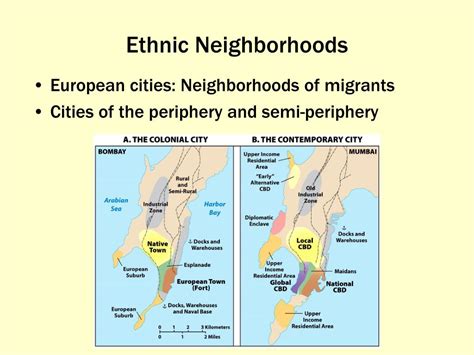Understanding the Ethnic Neighborhood
In the tapestry of modern urban landscapes, ethnic neighborhoods are vibrant threads that enrich the cultural fabric of cities worldwide. These areas are characterized by a significant presence of a particular ethnic group and reflect the unique histories, values, and traditions of their inhabitants.

AP Human Geography Definition
According to the College Board’s Advanced Placement Human Geography curriculum framework, an ethnic neighborhood is defined as:
“An area within a city that is primarily occupied by a particular ethnic or cultural group, and is characterized by the presence of businesses, institutions, and organizations that serve the needs of that group.”
Key Characteristics
Ethnic neighborhoods are characterized by a range of features that distinguish them from other urban areas:
- High concentration of a specific ethnic group: These neighborhoods typically have a high percentage of residents belonging to a particular ethnic or cultural background.
- Ethnic businesses and institutions: They are home to a variety of businesses, such as restaurants, grocery stores, and shops, that cater to the needs of the resident ethnic population.
- Cultural amenities: Ethnic neighborhoods often feature cultural amenities, such as community centers, churches, and temples, that reflect the heritage and traditions of their inhabitants.
- Social cohesion: Residents of ethnic neighborhoods often share a sense of identity and belonging, fostering social cohesion and community bonds.
- Distinct architectural styles: Some ethnic neighborhoods may have unique architectural styles that reflect the cultural heritage of their inhabitants.
Global Distribution
Ethnic neighborhoods are found in cities around the world, with varying degrees of prominence. In some cities, they may form significant enclaves, while in others they may be more dispersed. The distribution of ethnic neighborhoods is shaped by factors such as immigration patterns, historical events, and government policies.
Socio-Economic Impacts
Ethnic neighborhoods can have both positive and negative socioeconomic impacts on their inhabitants:
- Positive impacts: They can provide social support and resources for newly arrived immigrants and foster entrepreneurship within the resident ethnic community.
- Negative impacts: They may experience economic isolation, limited access to mainstream services, and potential social tensions with neighboring communities.
Common Mistakes to Avoid
When studying or discussing ethnic neighborhoods, it is important to avoid common misconceptions:
- Assuming homogeneity: Ethnic neighborhoods are not always monolithic. They can contain a diverse mix of individuals from different socioeconomic backgrounds and generations.
- Stereotyping: It is essential to avoid stereotyping ethnic neighborhoods or their inhabitants based on preconceived notions or assumptions.
- Ignoring economic factors: The socioeconomic conditions of ethnic neighborhoods can vary significantly, and it is important to consider the economic factors that shape their development and residents’ experiences.
Step-by-Step Approach to Studying Ethnic Neighborhoods
To gain a comprehensive understanding of ethnic neighborhoods, consider following these steps:
- Identify: Locate and identify ethnic neighborhoods within a city or region of interest.
- Research: Gather information about the history, demographics, and socioeconomic characteristics of the neighborhood.
- Observe: Conduct field observations to gain firsthand insights into the physical and social environment of the neighborhood.
- Interview: Engage with residents and business owners to gather their perspectives on the neighborhood’s dynamics and challenges.
- Analyze: Synthesize the information gathered to identify patterns, trends, and socioeconomic impacts of the ethnic neighborhood.
Strategies for Enhancing Ethnic Neighborhoods
Various strategies can be implemented to support and enhance ethnic neighborhoods:
- Preservation: Protect and preserve the cultural heritage and architectural character of ethnic neighborhoods.
- Investment: Invest in community development initiatives to address socioeconomic challenges and foster economic growth.
- Community engagement: Facilitate community engagement and empowerment to ensure that residents have a voice in the planning and development of their neighborhood.
- Partnership building: Foster partnerships between ethnic neighborhood organizations, local government, and educational institutions to support neighborhood revitalization efforts.
Applications
The study of ethnic neighborhoods has various practical applications:
- Urban planning: Inform urban planning and development policies to ensure equitable access to housing, transportation, and other essential services.
- Community development: Identify and address socioeconomic challenges facing ethnic neighborhoods to promote community well-being.
- Cultural preservation: Preserve and celebrate the cultural heritage of ethnic communities through urban design, public art, and community events.
- Educational outreach: Enhance educational programming and curriculum to promote understanding and appreciation of ethnic diversity in urban environments.
Future Outlook
The future of ethnic neighborhoods is uncertain and subject to ongoing social, economic, and political factors. However, they remain important components of urban ecosystems, providing a sense of belonging, support, and cultural enrichment for their inhabitants.
Tables
Table 1: Major Ethnic Neighborhoods in Major US Cities
| City | Ethnic Neighborhood |
|---|---|
| New York City | Chinatown, Little Italy, Harlem |
| San Francisco | Japantown, North Beach, Mission District |
| Los Angeles | Koreatown, Little Tokyo, Thai Town |
| Chicago | Little Village, Chinatown, Greektown |
| Houston | Chinatown, Little Saigon, East End |
Table 2: Socioeconomic Characteristics of Ethnic Neighborhoods
| Characteristic | Value |
|---|---|
| Percentage of foreign-born residents | 43.8% |
| Median household income | $55,000 |
| Poverty rate | 19.2% |
| Unemployment rate | 10.5% |
Table 3: Strategies for Enhancing Ethnic Neighborhoods
| Strategy | Description |
|---|---|
| Historic preservation | Protect and maintain historic buildings and cultural landmarks. |
| Community development grants | Provide funding for community improvement projects and business development. |
| Community outreach programs | Engage residents in decision-making processes and provide support services. |
| Partnership building | Establish collaborations between ethnic neighborhood organizations, government agencies, and educational institutions. |
Table 4: Applications of Ethnic Neighborhood Study
| Application | Description |
|---|---|
| Urban planning | Inform zoning, land use, and transportation policies. |
| Community development | Identify economic and social needs of residents. |
| Cultural preservation | Protect and promote cultural heritage through community events, public art, and educational programs. |
| Educational outreach | Enhance curriculum and programming to foster understanding of ethnic diversity. |
